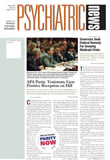A team of National Institute of Mental Health (NIMH) researchers has linked the inheritance of a specific gene to a difference in how people respond to pictures of scary faces, adding that people with the gene could be at higher risk for anxiety disorders.
The researchers used functional magnetic resonance imaging (fMRI) to measure how active a particular area of each subject’s brain became in response to visual images of fearful or angry faces.
“How biologically reactive we are to a signal of danger, which is partly heritable,” explained Daniel Weinberger, M.D., chief of NIMH’s Clinical Brain Disorders Branch, “can place us at risk for an anxiety disorder or it may be an adaptive, positive attribute, such as increased vigilance, depending on the circumstances.”
Weinberger, the lead investigator and principal author of the report, emphasized in an NIMH press release, however, that anxiety is a complex experience that is not caused by one gene or any specific environmental factor but rather a complex interaction of many genes and environmental factors. The report, which appeared in the July 19 issue of Science, shows how a “variation in a gene exerts its influence on the brain’s center for fear processing,” he said.
The gene identified by the group codes for the protein in neuronal cell membranes responsible for the recycling of serotonin from synapses—the serotonin reuptake transporter. (Selective serotonin reuptake inhibitor drugs, used as antidepressants, are believed to somehow block this transporter.) The two most common variations of the gene occur in a region of the gene that acts like a “dimmer switch,” according to the NIMH group, controlling the level of the gene’s turning on and off. The “short variant” of the gene makes less protein, resulting in fewer transporters. Therefore, higher levels of serotonin remain in the synapse. As such, there is more binding of the neurotransmitter to serotonin receptors on connecting neurons resulting in a higher degree of stimulation of the connecting neuron. This difference in the “level of activation” can be seen in fMRI images taken at different times, under different circumstances.
The researchers used fMRI to look at 28 subjects while completing a facial emotion-matching task on a computer screen. Subjects were asked to look at a picture of two faces, each expressing either anger or fear, and match the correct picture to a third face, established as being angry or afraid.
The facial emotion-matching task is known to activate the amygdala, the brain structure that the NIMH researchers referred to as the “hub of fear.” Imaging monitored the activity of the amygdala in each subject during the task. Weinberger said that those subjects with one or two copies of the short gene variation showed greater activation of their amygdala on the right side of the brain, which specializes in facial recognition. When the same subjects were asked to perform a common cognitive test that does not involve emotion, no effects of the gene difference were seen.
The current study was not capable of determining any differences in anxiety level or traits related to the serotonin transporter gene variations as that was not the primary goal, and the team believes its sample was too small to see any significant correlation if they had looked for it. Earlier studies, however, in particular by Dennis Murphy, M.D., also at NIMH, have found that the variants accounted for 3 percent to 4 percent of the variance they found in anxiety traits.
“This fMRI study takes the genetic analysis forward from the level of neurobiology, closing one more link in the chain of causality between a functional difference in a gene and a complex behavior,” noted David Goldman, M.D., a researcher at the National Institute on Alcohol Abuse and Alcoholism and coauthor of the report.
Weinberger agreed, noting that “this finding may lend credence to earlier reports linking the short variant to slightly higher levels of anxiety. It provides potential insight into one factor that contributes to the way people experience emotion.”
An abstract of “Serotonin Transporter Genetic Variation and the Response of the Human Amygdala” is posted on the Web at www.sciencemag.org/cgi/content/abstract/297/5580/400?. ▪
Science 2002 297 400
